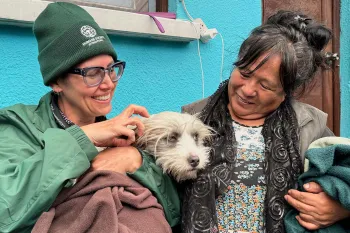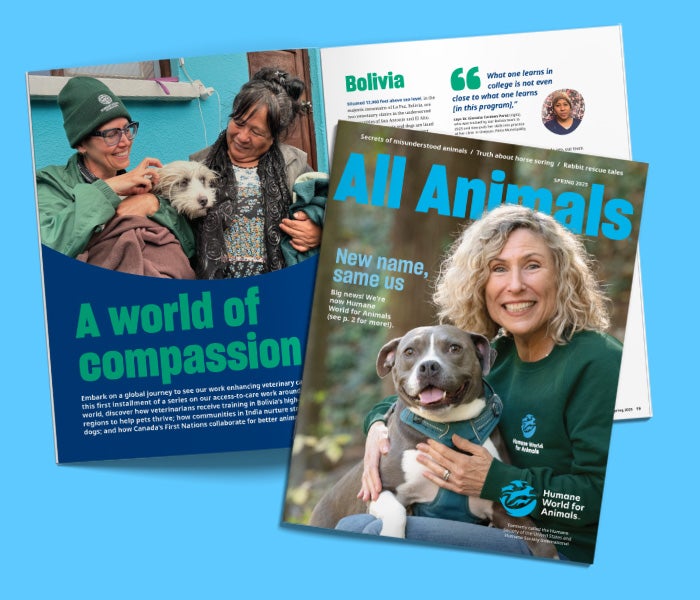Embark on a global journey to see our work enhancing veterinary care! Discover how veterinarians receive training in Bolivia’s high-altitude regions to help pets thrive; how communities in India nurture street dogs; and how Canada’s First Nations collaborate for better animal health.
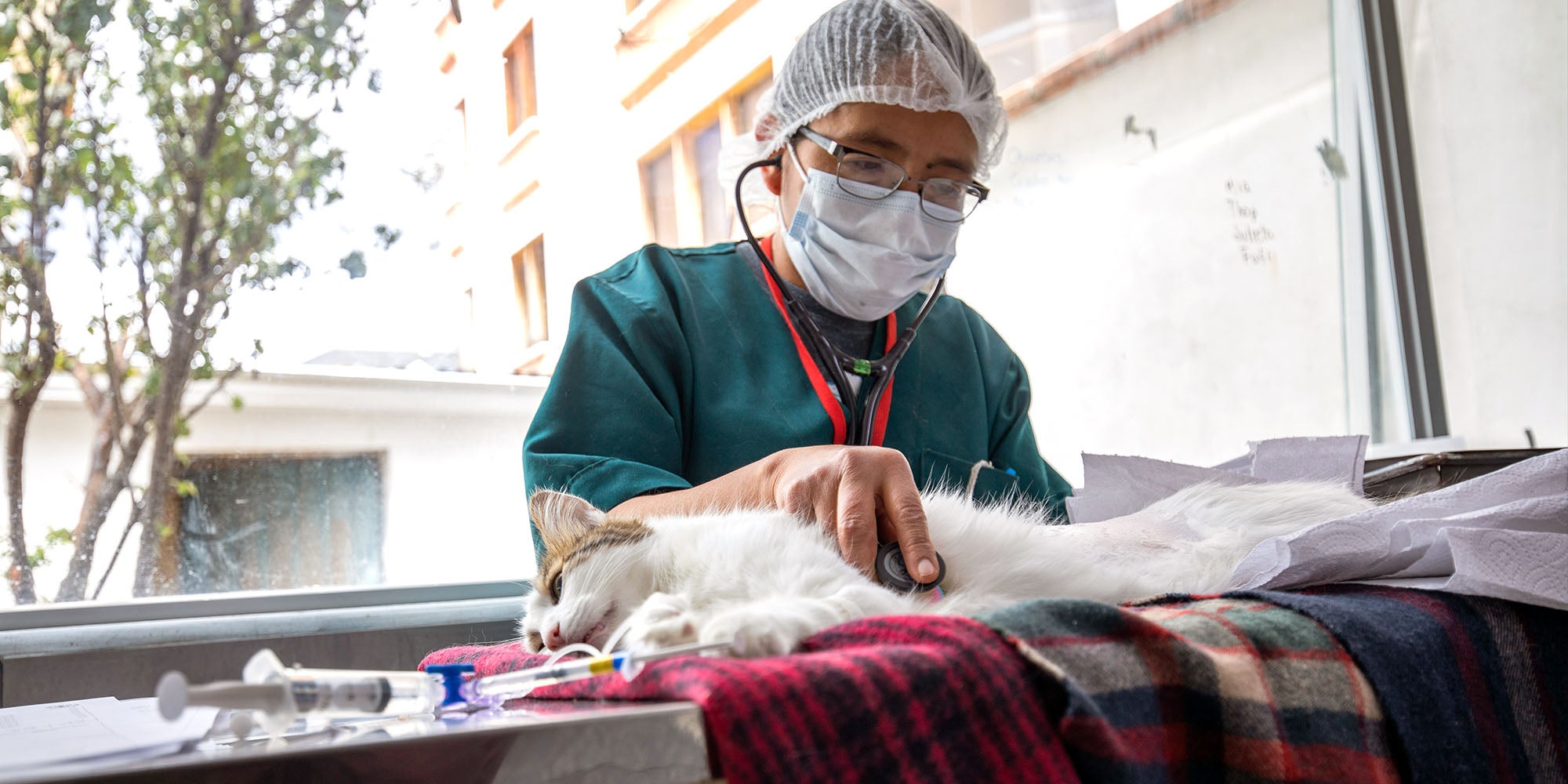
Claudio Ramirez/For Humane World for Animals
Bolivia
Situated 12,000 feet above sea level, in the majestic mountains of La Paz, Bolivia, are two veterinary clinics in the underserved communities of San Antonio and El Alto. Outside the clinics, cats and dogs are lined up wearing colorful sweaters to protect them from the high-altitude temperatures. Their families await the low-cost spay/neuter services offered by our Latin America veterinary training program.
Our state-of-the-art program offers a unique opportunity for hundreds of veterinary professionals from countries across Latin America to hone their skills in spay/neuter surgery and, as a result, thousands of dogs and cats have received this care.
In Bolivia, as in most parts of Latin America, qualified veterinary surgeons are few and far between. Most veterinary schools do not provide adequate instruction regarding small-animal welfare.
More than a decade ago, our team recognized Dr. Maria Rene Selaya’s exceptional technical expertise and natural teaching abilities during one of our trainings. In 2014, we partnered with her clinic to establish a Latin America veterinary training program in Bolivia.
“The most important thing about this training program,” Selaya says, “is that we teach respect and compassion for animals—subjects that are not taught in vet schools—and it is improving the way dogs and cats are treated across the entire Latin American region.”
We trained Dr. Ana Rosa Calderón, who directs an animal control center in Santa Cruz, Bolivia, in early 2024. “What has impacted me the most,” Calderón says, “is the commitment of the trainers, the time they give to each participant and the level of detail they go into. They evaluate your weaknesses and reinforce your strengths, which is incredible, because that rarely happens in training.”
These clinics also provide affordable services to the public: Pet owners pay only a fraction of the cost they would typically pay a private veterinarian, reducing a major barrier to obtaining spay/neuter services for their beloved animals.
—Kaz Zaleski, director of companion animals and engagement
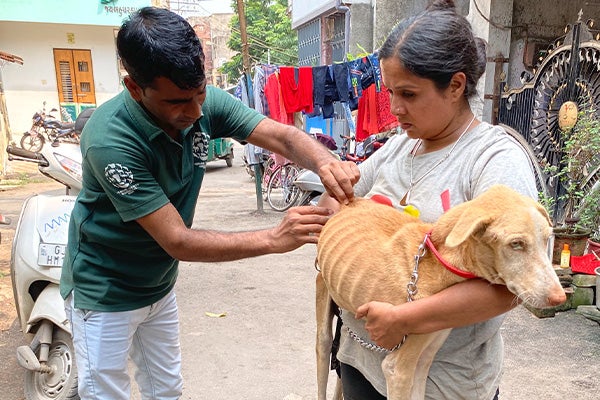
Manish Parmar/Humane World for Animals
India
In October 2022, Roshan Chhetri found Maxy, then a pup, abandoned on the side of a road in Dehradun. She tried finding her a home, with no luck, so Maxy joined the family. “I was depressed,” says Chhetri, “but when I found Maxy, her unconditional love brought me out of it. It gives me immense pleasure to care for her and all the other dogs.”
Roshan and her husband, both dedicated animal advocates, have adopted three dogs and care for 180 street dogs within 10 kilometers of their home. Our team at Humane World for Animals India has sterilized and vaccinated all 183 animals.
Maxy, one of the estimated 85 million dogs living in India, is lucky. For most street dogs and 8.8 million cats, every day is fraught with uncertainty. There is little to no access to care from government or private services.
The street dogs Roshan and her husband care for are fortunate to have a compassionate community looking out for them. Our work with communities in three large cities in India—Dehradun, Vadodara and Lucknow—focuses on improving access to care for street dogs who aren’t as fortunate in diverse neighborhoods across cities.
Shweta Dubey, from Vadodara, Gujarat, says, “For many years, I have been caring for street dogs to the best of my ability, but after attending the first aid training, I have helped over 73 dogs and cats get effective treatment and care. I use gloves, avoid turmeric on wounds and always take them to a veterinarian for further care.”
Access to care includes access to accurate information, which sometimes can be difficult to obtain in certain parts of India. Herbs such as turmeric, which have medicinal properties, are often used to treat animals. But without knowing an animal’s medical history, they can cause harm.
To address the lack of services in the city of Vadodara, we compiled a directory of local resources that facilitate care, treatment and support for animals living on the streets. And in Hubli-Dharwad, our team launched the city’s first mobile veterinary clinic in 2019. This service has provided high-quality treatment, surgeries and care to over 3,000 animals to date.
There’s still much work to do to help more animals like Maxy. Conducting dog behavior workshops in neighborhoods, schools and where people interact with street dogs is a key step to improving these relationships. Expanding our work by building local capacity is vital, given the volume of everyday challenges confronting dogs and cats, especially those who live freely on the streets.
—Keren Nazareth, senior director of companion animals and engagement for Humane World for Animals India
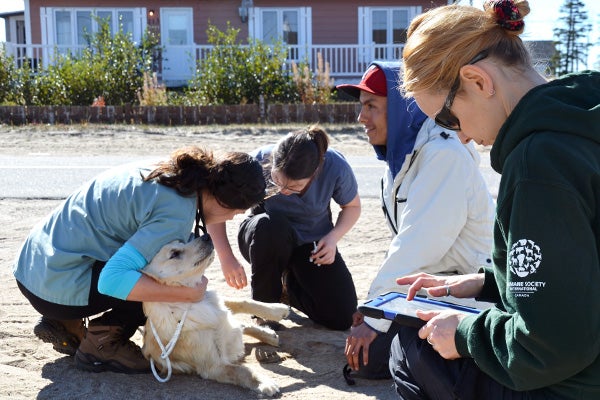
Michael Bernard/Humane World for Animals
Canada
For thousands of years, Indigenous people have lived in harmony with dogs in remote communities across Canada. While some dogs live in homes, many others roam the streets and are cared for by local residents. These dogs hold an important place in the communities and greet residents with wagging tails, especially when treats are offered.
Unfortunately, the geographic isolation and systemic poverty experienced by many First Nations (who are among the Indigenous peoples of Canada) often prevent access to veterinary care. Without these services, critical problems quickly compound, such as large unsterilized dog populations that can lead to increased rates of dog bites and serious injuries and illnesses for humans, including zoonotic diseases such as rabies.
Because no government action has been taken, Indigenous communities and veterinary professionals have come together to find a solution. With strong support from Humane World for Animals Canada, volunteer groups including Chiots Nordiques in Quebec and the Canadian Animal Task Force in Alberta are working hand in hand with First Nations to organize free temporary veterinary clinics in their areas.
With our support, veterinarians, veterinary technicians and other volunteers travel for many hours by road, boat or charter flights to reach these secluded regions. Then, staff set up clinics in community spaces such as school gymnasiums. We provide examinations, sterilizations and emergency veterinary services for community dogs in need, with teams often working around the clock for multiple days while treating hundreds of animals.
In every clinic, we see the sad outcomes of restricted veterinary access: a child bringing in a family dog who has suffered from a broken leg for weeks; a sick puppy found dying of a preventable disease; a community dog suffering from a severely infected wound. But our team brings hope to the animals and the community and, through sterilization and vaccination, prevents future hardship.
We have supported the work of Chiots Nordiques for over a decade and that of the Canadian Animal Task Force for the past few years. Since 2013, we have sponsored these organizations in holding nearly 40 temporary clinics and have helped over 5,800 cats and dogs in urgent need. To increase our impact, staff are pressing governments to develop longer-term solutions, including building regional infrastructure and inclusion of veterinary care in government-sponsored essential service missions. In the meantime, the team will continue to support the critical interventions that improve the lives of both animals and people in remote Indigenous communities.
—Ewa Demianowicz, senior manager of campaigns for Humane World for Animals Canada
